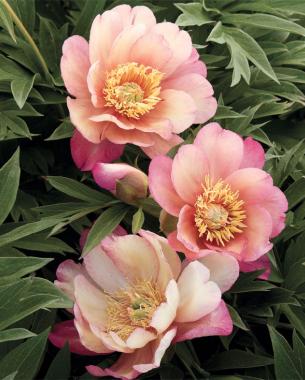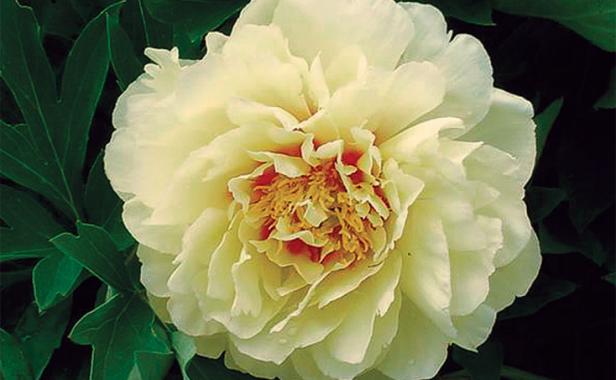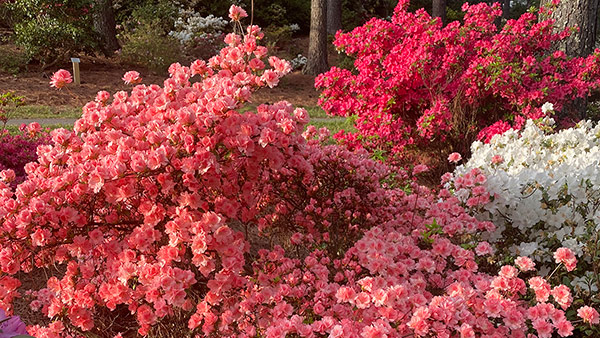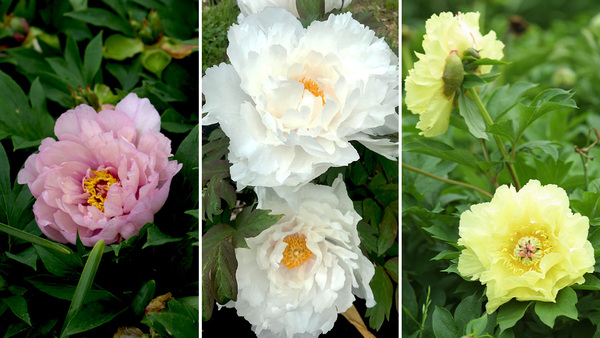Don’t let their beauty fool you. Peonies (Paeonia spp. and cvs., USDA Hardiness Zones 3–8) are not high-maintenance divas. Despite their gorgeous blooms, peonies, once established, are some of the most easygoing perennials you’ll ever grow.
For most of us, old-fashioned herbaceous peonies are the first type of peony that comes to mind. But that’s just scratching the surface. There is also the tree peony, which the Chinese have cultivated for well over a thousand years, and the intersectional (or Itoh) peony, which was first introduced by its namesake in the late 1940s after successfully crossing a tree peony with an herbaceous variety. All three types are cold hardy, deer resistant, and relatively pest-free, and they require next to no pampering.
But we all know the real reason that gardeners go gaga over peonies—and it’s not because peonies are not fussy. How could anyone resist those blooms? Although all peonies are beautiful, there are some significant differences among the three types of peonies. From bloom time to stem strength to fragrance, each type has its own selling points and a few different growing preferences. You might even find that one kind suits your garden better than the others.
Herbaceous varieties offer the longest bloom season
The herbaceous peony is the type your grandparents would know best. And it still ranks as America’s best-selling peony for two reasons: It’s often the least expensive, and it offers the widest range of bloom times. Although a single plant may only flower for a week or two, you can have peonies blooming for up to seven weeks if you plant a mix of very early to very late bloomers. And because peonies are frequently classified by their bloom period, it doesn’t take much research to create a long-lasting show. You’ll find that heirloom varieties often boast heavenly fragrances and knockout flowers, but they’re also prone to flop in the rain. If you don’t want to bother with staking, seek out newer herbaceous hybrids with stronger stems; just be prepared for unscented flowers. Fragrance is often one of the first traits sacrificed in the hybridization process.
For the best results, plant herbaceous peonies in Zones 3 to 8 and give them plenty of sunshine and fertile soil with a pH of at least 6.0. As their name suggests, herbaceous peonies die back each fall. To prevent pests and diseases from overwintering, cut the plant’s stems clear to the ground shortly after the first frost and throw away the debris.
‘Rare Flower of Frost Dew’ Photo/Illustration: Cricket Hill Gardens
‘Rare Flower of Frosty Dew’
‘Rare Flower of Frosty Dew’ is a late-blooming Chinese variety with skyward-facing, intensely fragrant blooms.
Name:P. lactiflora ‘Rare Flower of Frosty Dew’ (syn. ‘Qi Hua Lu Shuang’)
Type: Herbaceous
Size: 3 feet tall and 2 feet wide; 5- to 6-inch-diameter blooms

‘Festiva Maxima’
An heirloom variety that never lost favor, ‘Festiva Maxima’ is still one of the most fragrant peonies you can buy. Whereas most double flower forms are short-lived in hot, humid weather, this variety is an exception. Warm-climate gardeners typically have the best luck, however, with single or semi-double, early-season bloomers.
Name:P. lactiflora ‘Festiva Maxima’
Type: Herbaceous
Size: 3 feet tall and 2 to 3 feet wide; 5- to 7-inch-diameter blooms

Tree peonies boast the biggest blooms
Just as bulbs are waning but before most perennials kick into gear, tree peonies offer a welcome pop of color. They are among the first peonies to bud, and their flowers, once fully open, can span a foot wide. If you thought you didn’t have enough sun to grow peonies, think again. Tree peonies actually grow better in partial shade. (Too much sun makes their flowers fade faster.) Five to six hours of morning light is ideal. They grow best in rich soil with a pH of 6.5 to 7.2, which mimics their native land in China. Mature plants may eventually need thinning. By increasing air circulation and light, you make the plant less attractive to diseases and pests. If branches get too dense, cut out excessive interior growth in late winter, leaving behind the six to 10 strongest branches.
Tree peonies bud on old wood, so don’t make the mistake of cutting them to the ground. Shortly after the first frost, however, you should snip off all the leaves to keep diseases from overwintering. Because these woody shrubs don’t die back, they’re more vulnerable to winter damage and, therefore, less cold hardy than herbaceous or intersectional varieties. Gardeners in Zones 4 to 8 have the best success.
‘Flying Swallow in a Red Dress’
When the flowers of the vigorously growing ‘Flying Swallow in a Red Dress’ first open, they have a wonderful spicy rose fragrance, which mellows as the blooms fades.
Name:P. suffruticosa ‘Flying Swallow in a Red Dress’ (syn. ‘Fei Yan Hong Zhuang’)
Type: Tree
Size: 4 feet tall and wide; 8-inch-diameter blooms

‘Snow Lotus’
Name:P. rockii ‘Snow Lotus’ (syn. ‘Xue Lian’)A fast grower that towers above most tree peonies, ‘Snow Lotus’ can perfume a whole section of a garden when it’s in full bloom. Mature plants hoist dozens of flowers well above the foliage, making them easy to admire.
Type: Tree
Size: 5 feet tall and 4 feet wide; 8- to 10-inch-diameter blooms

Intersectionals sport the wildest colors
A cross between the tree and herbaceous peony, the intersectional peony offers the best of both worlds. Like the tree peony, it boasts huge flowers; attractive, long-lasting foliage; and woody stems that need no staking. But it has the same cold hardiness and growth cycle as an herbaceous peony. (Cut back intersectional peonies after the first frost as you would an herbaceous variety.) Best of all, intersectional varieties are less vulnerable to botrytis blight than their parent plants and recover remarkably fast after root division.
But what really makes gardeners swoon are its flowers in striking shades of yellow and lavender. Such vibrant colors make it easier to accept that most of the blooms are light on fragrance. But because intersectional peonies are the product of hybridizers and not nature, they are subject to some instability. On any given year, a whole plant may bloom in a slightly different shade or one-half of a flower will be a different color than the other half. For many gardeners, however, this unpredictability makes intersectional peonies all the more interesting.
‘Julia Rose’
Name:P. ‘Julia Rose’This gorgeous early bloomer grows quickly, requires no staking, and produces loads of spicy-scented blooms. Peach, pink, and yellow flowers often appear on ‘Julia Rose’ all at once.
Type: Intersectional
Size: 2 1/2 feet tall and 31/2 feet wide; 4-inch-diameter blooms

‘Bartzella’
Perhaps the most celebrated yellow peony, ‘Bartzella’ is a shapely plant that looks great in and out of bloom. Spring is its glory season, however, when dozens of hefty, lemon-scented flowers adorn this vigorous grower.
Name:P. ‘Bartzella’
Type: Intersectional
Size: 2 1/2 feet tall and 4 feet wide; 7- to 9-inch-diameter blooms

Give Them a Good Start: How to Grow Peonies

Before a peony can become a tough, low-maintenance plant, it needs to get its footing. Planting in fall so that the root system gets a head start, mulching to prevent frost heaving, and watering during dry spells all help ensure a good first year, as will the following five tips:
- Pick a sunny, well-drained spot. For peonies, there’s no substitute for good drainage, plenty of light, and rich soil. Also, never plant a peony in the same spot where another peony once grew. The new plant simply won’t survive, and scientists are still uncertain why.
- Dig a really deep hole. Regardless of the root division’s size, dig a hole that is roughly 2 feet wide and 2 feet deep. You don’t have to shovel out all of the soil, but make sure that the area is clear of any roots or rocks that might compete with the peony’s root system.
- Amend the soil with trace minerals. “Peonies are like tomatoes in one respect,” says Roger Anderson, a noted intersectional hybridizer. “Too much nitrogen gives you a beautiful-looking plant but no flowers.” When selecting fertilizer, opt for one low in nitrogen and high in phosphorus. Adding bonemeal or rock powder also boosts the content of trace minerals.
- Plant them at the right depth. If you plant herbaceous or intersectional peonies too deep, they won’t bloom. And you’ll get the same sad results from tree peonies if you plant them too shallow. For bare-root herbaceous plants, position the top eye (or bud) 1 to 2 inches beneath the soil’s surface. Bare-root intersectional plants are more forgiving on depth, but don’t plant the top eye deeper than 3 inches (photo, left). Tree peonies, on the other hand, perform better when planted deep. Position the graft point of a bare-root tree peony between 4 and 6 inches below the surface. For tree peonies growing on their own roots, place roughly 2 inches of soil over the crown.
- Keep them going strong. Not allowing other plants to crowd your peonies and doing a good fall cleanup are your best defenses against powdery mildew and botrytis blight. If outbreaks occur, however, you can keep the situation under control by applying a fungicide that contains copper sulfate or a microbe-based solution, such
as Actinovate.
Fine Gardening Recommended Products

ARS Telescoping Long Reach Pruner
Fine Gardening receives a commission for items purchased through links on this site, including Amazon Associates and other affiliate advertising programs.

Spearhead Shade Gardening Shovel with Steel-Reinforced Fiberglass Handle
Fine Gardening receives a commission for items purchased through links on this site, including Amazon Associates and other affiliate advertising programs.

Lee Valley Garden Knife
Fine Gardening receives a commission for items purchased through links on this site, including Amazon Associates and other affiliate advertising programs.


















Comments
Log in or create an account to post a comment.
Sign up Log in